

|

|
Power, Sound, R/C
:
Remote Control
An Introduction to DCC - Part 2
Feb 7, 2002


By Fred Hughes |
Author
Bio
Computers are invading every aspect of our lives and now "Digital Command Control" - DCC may be pushing its way into our gardens and this immediately raises some questions.
|
Computers are invading every aspect of our lives and now "Digital Command Control" - DCC may be pushing its way into our gardens and this immediately raises some questions.
- Should we complicate our gardens with techno-gizmo gadgets?
- Can DCC increase our enjoyment?
- What advantages can DCC offer?
- Can a novice install DCC?
Before we can answer these we need to understand exactly what DCC is and how it works.
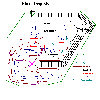
Author's Layout Plan
Click for larger picture |  | When we install DCC in the garden the rails will be receiving a constant level of power at all times regardless of the speed or direction of movement of individual trains. This power is different from the traditional direct current 'DC' or alternating current 'AC' that is familiar to us all. DCC power is a combination of an electrical current and digital pulses not unlike "Morse code". |
Power is transmitted to the track as a series of dots and dashes, i.e. short and long current pulses. With the exception of motors most electrical devices on our layouts don't care if the power supplied is AC (alternating current), DC (direct current) or DCC (pulsed).
When DCC current is applied to the rails the amplitude and polarity of the power to the track no longer determines the speed and direction of travel. How is this possible? Although the track and therefore the locomotive are always fully powered, the installation of a small circuit board, a "mobile decoder", in each engine gives us the "Command Control" part of DCC. This device, installed in each engine, between the track pickups and the motor, allows the engineer to signal individual locomotives.
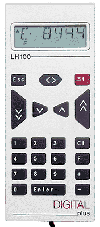
Lenz LH100V3 Throttle
Click for larger picture |  | By using a "Hand Throttle", the engineer automatically sends "messages" to each engine. These messages are "read" by the "mobile decoder" which in turn determines what polarity (direction) and percentage of "DCC power" (speed) is to be sent to that specific locomotive motor as DC current. Depending on the decoder and system installed, this power can be applied to the engine motor in as few as 14 increment "speed steps" or as many as 128 "speed steps". Additionally the size of the "speed steps" are either fixed or adjustable for each engine and engines can be combined into "consists" that work together as one, again depending on the decoder and base system installed. |
This means that when a "consist" of two or more engines are assembled we can adjust, or fine-tune each engine's "speed steps" so they work smoothly together. This may be far more than most modelers require and can be ignored if not needed. For G scale 28 speed steps is the default and used by most operators.
The advantage of DCC is especially significant for use in the garden. It means that any number of trains on the same track can all be moved in any direction at any speed independently without the need to have separate isolated blocks and transformers for each train. This frees the engineer from a control panel far from the action in the garden. As previously mentioned, constant track power means that smoke generators, headlights, cab lights, ditch lights, mars lights, gyro lights, pulsed lights, car lighting, sound systems all function without regard to the movement of the train. Suddenly Fred fireman can continue to shovel coal, as needed, even when the train is parked!

Lenz LE077 Decoder
Click for larger picture |  | Once we install a "mobile decoder" in each engine we can assign the decoder a number or "Address". Depending on the DCC system being used, the numbers, "Addresses" can range from 1 to 10, or 1 to 9999. In most cases we can assign the actual engine prototype number. These "addresses" may also be combined into "Consists" of 2 or more engines that are then "addressed" and controlled as one unit. |

Track Plan
Click for larger picture |  | As our trains travel around the layout they will constantly be receiving "Morse Code" or "Digital Bit Packets" of information that contain the "Commands" that will "Control" the various functions for that train. This gives us the derivation of the name "Digital Command Control" or DCC. |
Now, not only can we control the speed and direction of travel for each individual train, we can also control individual features for specific trains. We can activate sound systems, blow a whistle, ring a bell, and turn a smoke generator on or a headlight off. Depending on the model of mobile decoder installed as many as 12 different actions can be controlled independently for each train. Many decoders include features that will allow for simple settings to turn on forward or reverse lights automatically or provide special effects for gyro, pulsed, dimming or other options. These features are just part of the standard options in the latest decoders.
DCC can also be used for features in our garden other than our engines and rolling stock. "Accessory Decoders" are available and can be installed to POWER and CONTROL such devices as crossing guards, turnouts, building lights, street lights, action displays and much much more. Like the mobile decoders each accessory is assigned an "Address" (number) that will again allow us to control these devices with our "Hand Throttle". Sometimes we might have several decoders use the same address if for example we want to turn on building lights for many locations with one command.
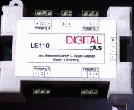
Lenz LS110
Accessory Decoder |  | Again as with the mobile decoders there are many special "accessory decoders" options such as timed output power for crossings or special applications. Variable speed pulse power for blinking lights or signs. Options for all kinds of turnouts, tortoise, twin-coil, BI-polar. |
Besides operating these features by our "Hand Throttle" these features can also be controlled by simple reed switches triggered by magnets on the trains. We can control features by one, the other or both. The choice is yours.

Track Plan
Click for larger picture |  | In my garden, operating the Hiwan Loop, I find that one hand throttle is sometimes not enough when the grandkids arrive. Fortunately DCC allows for the use of multiple hand throttles. |
This means no one has to wait for a turn. Unfortunately DCC does not guarantee the competence of the engineer (an unfortunate disadvantage!). This is when I revert to VCC (Voice Command Control), "Lexi PLEASE don't run into your brother's train!!"
These are a few advantages DCC but there are still questions.
- Who are the major manufacturers?
- What are the costs?
- Can we start slowly?
Top of Page
|
|

|
IMPORTANT LINKS
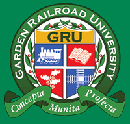
Get Your Official Diploma

Watch New Videos
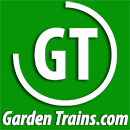

New Products Online
|
|



